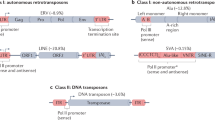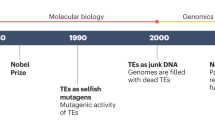Abstract
Mobile genetic elements have been identified in several eukaryotic organisms and some classes have been found to share common structural features with the proviral forms of animal retroviruses1–7. The representatives of this class of mobile elements in the yeast Saccharomyces cerevisiae are called Ty elements8, which could be a useful model system for studying the transposition of retrovirus-like elements. Here we have attempted to answer two questions often raised in discussions of the biological importance of transposition: what is the frequency of spontaneous Ty transposition, and are there certain chromosomal regions into which Ty elements preferentially integrate? We chose the LYS2 gene to investigate these questions because it allows direct selection of both mutants and revertants9. We have found that 2% of spontaneous lys2 mutants are caused by Ty transposition with a preferential integration into the transcription initiation region.
This is a preview of subscription content, access via your institution
Access options
Subscribe to this journal
Receive 51 print issues and online access
$199.00 per year
only $3.90 per issue
Buy this article
- Purchase on Springer Link
- Instant access to full article PDF
Prices may be subject to local taxes which are calculated during checkout
Similar content being viewed by others
References
Temin, H. M. Cell 21, 599–600 (1980).
Eibel, H., Gafner, J., Stotz, A. & Philippsen, P. Cold Spring Harb. Symp. quant. Biol. 45, 581–591 (1981).
Elder, R. T., Loh, E. T. & Davis, R. W. Proc. natn. Acad. Sci. U.S.A. 80, 2432–2436 (1983).
Rubin, G. M. et al. Cold Spring Harb. Symp. quant. Biol. 45, 619–628 (1981).
Flavell, A. J. & Ish-Horowicz, D. Nature 292, 591–595 (1981).
Shiba, T. & Saigo, K. Nature 302, 119–124 (1983).
Varmus, H. E. in Mobile Genetic Elements (ed. Shapiro, J. A.) 411–503 (Academic, New York, 1983).
Cameron, J. R., Loh, E. T. & Davis, R. W. Cell 16, 739–751 (1979).
Chattoo, B. B. et al. Genetics 93, 651–665 (1979).
Southern, E. J. molec. Biol. 98, 503 (1975).
Eibel, H. & Philippsen, P. Molec. gen. Genet. 191, 66–73 (1983).
Roeder, G. S. & Fink, G. R. in Mobile Genetic Elements (ed. Shapiro, J. A.) 299–328(Academic, New York, 1983).
Williamson, V. M. Int. Rev. Cytol. (in the press).
Chattoo, B. B., Palmer, E., Bun-Ichiro, O. & Sherman, F. Genetics 93, 67–79 (1979).
Gafner, J. & Philippsen, P. Nature 286, 414–418 (1980).
Farabaugh, P. J. & Fink, G. R. Nature 286, 352–356 (1980).
Roeder, G. S. & Fink, G. R. Cell 21, 239–249 (1980).
Roeder, G. S., Farabaugh, P. J., Chaleff, D. T. & Fink, G. R. Science 109, 1375–1380 (1980).
Williamson, V. M., Young, E. T. & Ciriacy, M. Cell 23, 605–614 (1981).
Williamson, V. M., Cox, D., Young, E. T., Russel, D. W. & Smith, M. Molec. cell. Biol. 3, 20–31 (1983).
Errede, B. Cell 25, 427–436 (1980).
Montgomery, D. L. et al. J. biol. Chem. 257, 7756–7751 (1982).
Jauniaux, J.-C., Dubois, E., Vissers, S., Crabeel, M. & Wiame, J.-M. EMBO J. 1, 1125–1131 (1982).
Scherer, S., Mann, C. & Davis, R. W. Nature 298, 815–819 (1982).
Gafner, J., DeRobertis, E. & Philippsen, P. EMBOJ. 2, 583–591 (1983).
Goldberg, M. L. thesis, Stanford Univ. (1979).
Ikenaga, H. & Saigo, K. Proc. natn. Acad. Sci. U.S.A. 79, 4143–4147 (1982).
Snyder, M. P. et al. Proc. natn. Acad. Sci. U.S.A. 79, 7430–7443 (1982).
Hayward, W. S., Neel, B. G. & Astrin, S. M. Nature 290, 475–480 (1981).
Payne, G. S., Bishop, M. J. & Varmus, H. E. Nature 295, 209–214 (1982).
Kuff, E. L. et al. Nature 302, 547–548 (1983).
Schnieke, A., Harbers, K. & Jaenisch, R. Nature 304, 315–320 (1983).
Messing, J. 3rd Cleveland Symp. Macromolecules: Recombinant DNA (ed. Walton, A.) 143–153 (Elsevier, Amsterdam, 1981).
Smith, G. E. & Summers, M. D. Analyt. Biochem. 109, 123–129 (1980).
Rigby, P. W., Dieckmann, M., Rhodes, C. & Berg, P. J. molec. Biol. 113, 237–251 (1977).
Philippsen, P., Kramer, R. A. & Davis, R. W. J. molec. Biol. 123, 371–386 (1978).
Sutcliffe, J. G. Cold Spring Harb. Symp. quant. Biol. 43, 77–90 (1978).
Bolivar, F. et al. Gene 2, 95–113 (1977).
Yang, R. C. A., Liz, J. & Wu, R. Meth. Enzym. 68, 178–181 (1979).
Grunstein, M. & Hogness, D. Proc. natn. Acad. Sci. U.S.A. 72, 3961–3965 (1975).
Author information
Authors and Affiliations
Rights and permissions
About this article
Cite this article
Eibel, H., Philippsen, P. Preferential integration of yeast transposable element Ty into a promoter region. Nature 307, 386–388 (1984). https://doi.org/10.1038/307386a0
Received:
Accepted:
Issue Date:
DOI: https://doi.org/10.1038/307386a0
This article is cited by
-
Retrotransposon targeting to RNA polymerase III-transcribed genes
Mobile DNA (2018)
-
The population biology and evolutionary significance of Ty elements in Saccharomyces cerevisiae
Genetica (1992)
-
Ty virus-like particles in the Saccharomyces cerevisiae strain NCYC74
Current Genetics (1990)
-
Ty RNA levels determine the spectrum of retrotransposition events that activate gene expression in Saccharomyces cerevisiae
Molecular and General Genetics MGG (1990)
Comments
By submitting a comment you agree to abide by our Terms and Community Guidelines. If you find something abusive or that does not comply with our terms or guidelines please flag it as inappropriate.



